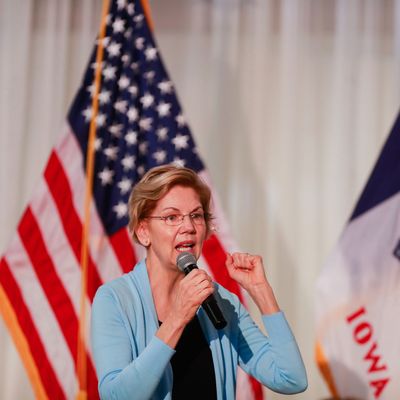
In rural areas, the Democratic Party looks weaker than it’s been in decades. Not only did rural voters overwhelmingly back Donald Trump in 2016 — a phenomenon rendered disproportionately influential by the Electoral College — Democratic incumbents lost major midterm races in Indiana, Missouri, and South Dakota, all states with significant rural populations. Among Democrats, there now appear to be two main schools of thought for winning back rural voters: A) Run a moderate and hope he or she appeals to conservative voters; or B) Run a progressive and hope that voters harmed by the vanishing of industry and bare-bones social services will come to trust government again.
So far, there’s not much evidence that either strategy is effective. Moderate politics didn’t save Claire McCaskill’s Senate seat in Missouri, and progressive congressional candidates in Virginia, Nebraska, and Pennsylvania failed to knock off Republican incumbents, though some did come close. Democratic presidential candidates are trying to solve the same problem, and they too seem to fall into two camps. On one side is Senator Amy Klobuchar of Minnesota, who courts rural voters with a familiar pragmatism. On the other sits Senator Bernie Sanders of Vermont, whose brand of democratic socialism proved popular with many rural Democratic voters in 2016. And on Wednesday, Senator Elizabeth Warren released a formal rural-policy plan that reinforces her position in the primary’s left-wing camp. Like Sanders, she’s hoping that rural voters will back ideas that renew the federal government’s commitment to their communities.
Warren’s proposal has two prongs: a general pledge to reinvest government resources in rural areas, and a blueprint for building what she calls “a new farm economy.” It’s quintessential Warren; distinguished by a level of detail that would seem technocratic if it lacked a sharp edge. But Warren is not Hillary Clinton. Rural voters, she writes, have been abandoned by the federal government and by Wall Street. In both sections of her proposal, Warren pledges to strictly regulate mergers in the hospital and agribusiness industries and addresses issues specific to Native American communities — a policy area often overlooked by presidential candidates. (The Warren campaign also recently announced that the candidate would attend a forum on Native American issues, and she was endorsed by Representative Deb Haaland of New Mexico, one of two Native women in Congress. But as she seeks to win the Native vote, Warren faces an obstacle of her own creation: Her decision to take a DNA test to “prove” Cherokee ancestry still rankles Native voters.)
Warren’s agribusiness proposals are worth a review, and her idea to create a public option for broadband access is fascinating, too. This post, however, will focus on her health-care proposals, which she outlines as part of a broader commitment to investment in rural places. To raise the number of health-care workers employed in rural areas, she’s pledged to increase the number of residencies in underserved areas and target half of those new residencies in rural communities. She also says that she would expand loan-repayment programs for health-care workers employed by the Indian Health Service and the National Health Service Corps, and she reaffirms her commitment to Medicare for All, which she says will mean “less uncompensated care for hospitals.” Her plan is notable, too, for her skepticism about hospital mergers. Warren writes that as president, she’d “direct” the Federal Trade Commission “to block all future mergers between hospitals unless the merging companies can show that the newly-merged entity will maintain or improve access to care.”
Hospital mergers don’t necessarily mean doom for rural patients. But research has shown that they can lead to higher prices for patients. Analysis published by the New York Times in 2018 found that in areas of high consolidation, “mergers have essentially banished competition and raised prices for hospital admissions in most cases.” A patient in need of an MRI, for example, may only be able to see one provider, which means he or she has no choice but to pay whatever price that provider sets. Not only can hospital mergers raise health-care costs, they often contribute to the consolidation of health-care services, a problem Warren singles out in her proposal. When hospitals merge, they cut costs by reducing the number of places that provide specific services. This can lengthen the already long drives rural patients take to get emergency services. These distances aren’t just a matter of cost and convenience for rural patients; often, they’re matters of life and death, too. Over half of all rural counties, for instance, lack a hospital that provides obstetric services. Concentrate services in a few regional locations, and rural patients in crisis might not be able to get to life-saving care in time.
Voters don’t see mergers as an abstract problem. In southwestern Virginia — where I grew up, and where my family still lives — a recent hospital merger sparked ongoing protests from patients who fear its consequences. Born of a union between Mountain States Health Alliance and Wellmont Health System, Ballad Health has announced drastic plans to reorganize care in western Virginia and eastern Tennessee. Extensive local reporting suggests that protesters have reason to worry. In June, the Roanoke Times reported that when a Ballad hospital in rural Norton, Virginia, stopped performing surgeries last October, it was “unclear if and when patients or state regulators were notified.” The Times also reported in July that protesters have demonstrated outside a Kingsport, Tennessee, hospital since May 2 in response to the news that Ballad “plans to downgrade both the trauma level in the emergency department and the level of care for newborns” and move those services to another hospital a half-hour down the road.
With rural hospitals in such crisis, it makes sense, then, that Medicare for All appeals to many voters affected by consolidation and closures. Sanders handily defeated Hillary Clinton in West Virginia’s Democratic primary. Sanders also won the rural vote in Nebraska, New York, Michigan, and won a number of coalfield counties in east Kentucky and southwest Virginia. Rural voters didn’t uniformly break for Sanders in 2016, and winning a state’s rural vote didn’t translate reliably to a statewide primary victory for the candidate. Nebraska’s primary voters still backed Clinton in the end. Nevertheless, Sanders’s performance in 2016 does suggest that a good number of rural voters are amenable to a message that emphasizes Medicare for All. In 2020, that could once again benefit Sanders, and now Warren, as long as she doesn’t backtrack on the issue.
A recent map of individual donor support affirms that conclusion. Produced by the New York Times, the map shows a concentration of individual donor support for Sanders in southern and central Appalachia, in rural Maine, and in portions of the rural west. Take Sanders off the map, and Appalachia’s individual donors seem to divide themselves between former vice president Joe Biden, who does not support Medicare for All, and Warren, who does. (The map also shows local hotspots of support for Mayor Pete Buttigieg, who says he supports single-payer health care but not the version of Medicare for All endorsed by Sanders and Warren.) Warren performs similarly well in western states with high concentrations of rural communities, like Utah, New Mexico, and Nevada.
So if Warren’s betting that rural Democrats may thrill to the notion of social democracy, she does so for good reason. Time will tell if she, and Sanders, are right.






























